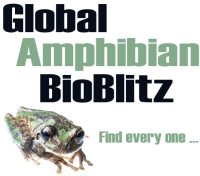Check this page for the latest news and updates from the Amphibian Ark team and our partners around the world.
AArk Conservation Grants open!
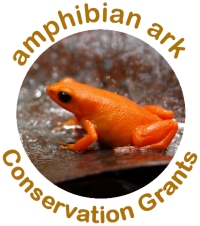 15 March – 15 April 2022
15 March – 15 April 2022
Applications close April 15, 2022.
Amphibian Translocation for Conservation Symposium
23 September–18 October 2019.
Amphibian Ark is leading an on-line Amphibian Translocation (Reintroduction and Reinforcement) for Conservation Symposium, 23 September–18 October 2019.
The symposium is especially intended for programs that have produced surplus animals, potentially as candidates for reintroduction programs, but with no clear reintroduction strategy in place. It also is intended to be helpful for managers and institutions interested in setting up amphibian conservation programs with a clear exit strategy focused on reintroduction.
If you are interested in participating or receiving more information please contact Luis Carrillo – luis@amphibianark.org.
Enrolment closes September 16.
Rescue Team Evacuates World’s Last Few Loa Water Frogs from Perilously Dry Habitat in Chile
International wildlife organizations call on Chilean Government to continue remarkable efforts by abolishing illegal water extraction and protecting frogs’ wild home. AArk is proud to be financially supporting this critical work. Anne Baker, e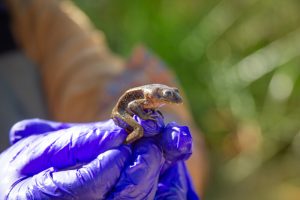 xecutive director, Amphibian Ark, said: “Amphibians have an important role to play in the ecosystems they inhabit, and they can’t fulfill this role if they’re only found in aquariums somewhere. But I am optimistic for the future of this species because of the amazing collaboration among the various parties, and a government that seems to be committed to the future of this species, as well. This sets up an environment in which success is very possible.”
xecutive director, Amphibian Ark, said: “Amphibians have an important role to play in the ecosystems they inhabit, and they can’t fulfill this role if they’re only found in aquariums somewhere. But I am optimistic for the future of this species because of the amazing collaboration among the various parties, and a government that seems to be committed to the future of this species, as well. This sets up an environment in which success is very possible.”
More information can be found on Global Wildlife Conservation’s blog.
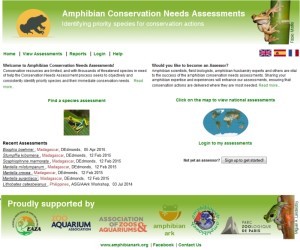 Online Conservation Needs Assessments
Online Conservation Needs Assessments
Amphibian Ark is very excited to announce the launch of our online Amphibian Conservation Needs Assessment program at www.ConservationNeeds.org. Since 2007, AArk staff and our partners have worked with our colleagues from the IUCN Amphibian Specialist Group (ASG), the international ex situ amphibian conservation community and other stakeholders to evaluate the conservation needs of 3,490 amphibian species. With the move to an online format, we are now able to continue these assessments in a more inclusive environment, with assessments for multiple countries being undertaken at the same time.
AArk releases position statement on proposed US trade regulation of amphibians
The Amphibian Ark has received a number of emails/calls concerning rumors of a ban on amphibian trade in the U.S. We have prepared a document that outlines the facts, the implications, the opportunities for you, and our official position so that our US partners and fans can make informed decisions for themselves. We hope that you find this information useful, and we welcome your feedback (AnneBaker@AmphibianArk.org).
Buy and sell on eBay for Amphibian Ark
You can support Amphibian Ark when you buy or sell on eBay, with the eBay Giving Works program. Here’s how: Amphibian Ark is part of the eBay Giving Works program. So, you can support our mission when you buy and sell on eBay. Here’s how:  Buy: You can find whatever you’re looking for on eBay – from baseball cards to new cars and more. When you do, shop for items that benefit us. You can get a great deal and support Amphibian Ark at the same time! See our Giving Works page Sell: You can also support Amphibian Ark when you sell on eBay. Just designate our organization to receive 10-100% of your final sale price the next time you list something great. See our Giving Works page.
Buy: You can find whatever you’re looking for on eBay – from baseball cards to new cars and more. When you do, shop for items that benefit us. You can get a great deal and support Amphibian Ark at the same time! See our Giving Works page Sell: You can also support Amphibian Ark when you sell on eBay. Just designate our organization to receive 10-100% of your final sale price the next time you list something great. See our Giving Works page.
 Jeff Corwin supports the Amphibian Ark
Jeff Corwin supports the Amphibian Ark
Jeff Corwin’s latest video in support of the Amphibian Ark talks about the goals of the AArk, and how you can help to save amphibians. Jeff is one of AArk’s Patrons, and is host and executive producer of The Jeff Corwin Experience and Corwin’s Quest, two American television shows on the Animal Planet cable channel. See Jeff’s video on our Video Gallery page.
 A message from our patron, Sir David Attenborough
A message from our patron, Sir David Attenborough
Amphibian Ark’s patron, Sir David Attenborough, talks about the plight of amphibians around the world, and lends his support to conserving amphibians. Read Sir David’s letter.
Clorox partners with Amphibian Ark
Clorox® Regular-Bleach signed on as the first official corporate sponsor of Amphibian Ark’s “2008 Year of the Frog”. Clorox Regular bleach, an EPA-registered fungicide, is one of the most important tools in Amphibian Ark’s fight to save the frogs. The Clorox Company will donate Clorox® Regular-Bleach to aid in the halt of the spread of chytrid fungus.  AArk is pleased to announce that Clorox® Regular-Bleach has signed on as the first official corporate sponsor of Amphibian Ark’s “2008 Year of the Frog,”. As part of its sponsorship, the company has donated Clorox® Regular-Bleach to aid in the halt of the spread of chytrid fungus. Clorox® Regular Bleach, an EPA-registered fungicide, is one of the most important tools in Amphibian Ark’s fight to save the frogs. Anything that has contact with water during amphibian rescue is treated with a bleach solution, from boots and clothing to instruments and transport containers, to be sure researchers are not spreading fungus to new, uncontaminated areas. When zoos and aquariums bring frogs that cannot be saved in the wild into protective custody, their enclosures are treated with a bleach solution daily for the first weeks to be sure they remain fungus-free.
AArk is pleased to announce that Clorox® Regular-Bleach has signed on as the first official corporate sponsor of Amphibian Ark’s “2008 Year of the Frog,”. As part of its sponsorship, the company has donated Clorox® Regular-Bleach to aid in the halt of the spread of chytrid fungus. Clorox® Regular Bleach, an EPA-registered fungicide, is one of the most important tools in Amphibian Ark’s fight to save the frogs. Anything that has contact with water during amphibian rescue is treated with a bleach solution, from boots and clothing to instruments and transport containers, to be sure researchers are not spreading fungus to new, uncontaminated areas. When zoos and aquariums bring frogs that cannot be saved in the wild into protective custody, their enclosures are treated with a bleach solution daily for the first weeks to be sure they remain fungus-free. 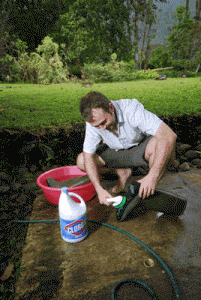 “We are grateful to Clorox for signing on as the first official sponsor of ‘2008 Year of the Frog’ and hope their commitment will encourage others to join this important global conservation mission,’” said Amphibian Ark Program Officer, Kevin Zippel. “Clorox’s support, along with the donation of bleach for use in our efforts, will make a real impact for the cause.” Since it was introduced in 1913, Clorox® Regular-Bleach has a long history of use in places where killing pathogens is critical — in hospitals, nursing homes, child-care centers and schools. “When we heard about Amphibian Ark’s campaign and learned that bleach played a critical role in its efforts, we wanted to help,” stated Mary O’Connell, public relations director at The Clorox® Company. “Amphibian Ark really is creating an ark in what’s become a race to save frogs and other amphibians not from decline – but from extinction. How could we not help?” Conservation biologists refer to amphibians as “the canaries in the coal mine” – they are among the first species to be affected by environmental stressors, so when they show declines in the wild, it serves as a warning to other species, including humans. Amphibians – frogs, toads, salamanders, newts and caecilians – are vital members of a delicate ecosystem as well as important environmental indicators and contributors to human health and wellness.
“We are grateful to Clorox for signing on as the first official sponsor of ‘2008 Year of the Frog’ and hope their commitment will encourage others to join this important global conservation mission,’” said Amphibian Ark Program Officer, Kevin Zippel. “Clorox’s support, along with the donation of bleach for use in our efforts, will make a real impact for the cause.” Since it was introduced in 1913, Clorox® Regular-Bleach has a long history of use in places where killing pathogens is critical — in hospitals, nursing homes, child-care centers and schools. “When we heard about Amphibian Ark’s campaign and learned that bleach played a critical role in its efforts, we wanted to help,” stated Mary O’Connell, public relations director at The Clorox® Company. “Amphibian Ark really is creating an ark in what’s become a race to save frogs and other amphibians not from decline – but from extinction. How could we not help?” Conservation biologists refer to amphibians as “the canaries in the coal mine” – they are among the first species to be affected by environmental stressors, so when they show declines in the wild, it serves as a warning to other species, including humans. Amphibians – frogs, toads, salamanders, newts and caecilians – are vital members of a delicate ecosystem as well as important environmental indicators and contributors to human health and wellness.
Why Do We Need an Amphibian Ark?
Kevin Zippel, first Executive Officer of Amphibian Ark said: ‘In response to the crisis of amphibian declines, the Amphibian Ark (AArk) would
- coordinate conservation activities
- assess amphibian species that may go extinct
- keep endangered species in captivity in suitable locations, such as zoos
- release animals into the wild when their survival can be assured
Amphibians have been around for over 360 million years, enduring at least three mass extinction events including the one that eliminated the dinosaurs. However, it remains to be seen how they will fare through the current extinction event.’
Can the “Amphibian Ark” Save Frogs from Pollution/Extinction?
From the July 2008 Scientific American Magazine By Charles Q. Choi Amphibians are going extinct faster than any other group of organisms. Since 1980, 122 species may have disappeared. Of the roughly 6,000 remaining, up to half are threatened; some 500 could go extinct in the next 50 years if not taken into captivity. Now zoos and other institutions worldwide are working together on an “Amphibian Ark” to help save all these species as they vanish in the wild, in the hope of one day returning them home. Read the full story: Scientific American Magazine
An Ark Program to Save Amphibians
Zoos and Aquariums Join to Protect Endangered Frogs and Salamanders Jul 13, 2007 Dawn M. Smith, suite101.com Scientists working to prevent extinctions as fungal disease spreads around the world. Coalition brings awareness of amphibian losses and spurs ark facility development. At a meeting held in Atlanta in February The Amphibian Ark, a coalition of interested parties from zoos, aquariums, museums, universities and wildlife organizations whose mission is to ensure the global survival of amphibian species, was launched. The project was conceived in the face of the growing threat from a chytrid fungus (Batrachochytrium dedrobatidis), which is wiping out populations of frogs and salamanders on every continent. In 2008 the Amphibian Ark will launch the Year of the Frog to raise awareness of the threats to amphibians and encourage funding of their programs.
World Zoos And Aquariums Develop Plan To Respond To The Extinction Of Frogs
ScienceDaily (Mar. 8, 2007) — Amphibians are facing great threats. About one third of the 6000 frog, toad, salamander and newt species are threatened with extinction, more than 120 species have likely become extinct since 1980, and 435 species have declined into a category of greater threat during that time.
In October 2005, WAZA, The World Zoo and Aquarium Association, therefore adopted a strong resolution calling on all zoos and aquariums to respond to the global extinction crisis facing the world’s frogs and other amphibians. This is part of a wider approach led by IUCN – The World Conservation Union, which encompasses also conservation measures in the field. Read the full story: Science Daily http://www.sciencedaily.com/releases/2007/02/070226161212.htm
A Fungus Brings Dinosaurs’ Fate to Frogs
February 20, 2007, 12:16 pm By TOM ZELLER JR. At the end of a report on National Public Radio’s “All Things Considered” program over the weekend, the host, Debbie Elliot, asked Dr. Joe Mendelson, an organizer of a project called “Amphibian Ark,” what it meant to humanity that roughly one-third of the planet’s 6,000 species of frogs, toads, salamanders, newts and worm-like caecilians may now be on the brink of extinction because of a disease spreading like wildfire among them. “Realize the precedent that amphibians are setting here,” Dr. Mendelson said. “A disease that we did not know existed, and we don’t from where it came, and we don’t know how it gets around, is working its way across an entire vertebrate class, eliminating species at an incredibly accelerated pace — and we can’t stop it.”
Read the full article: The New York Times http://thelede.blogs.nytimes.com/2007/02/20/a-fungus-brings-dinosaurs-fate-to-frogs/








